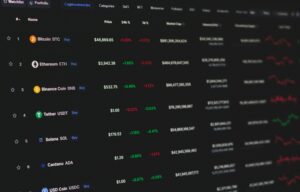X2Y2 NFT Marketplace Shuts Down as Trading Volume Plummets 90%

The NFT market continues to experience volatility, and the latest casualty is X2Y2, a once-thriving NFT marketplace that has officially shut down. The platform, which gained traction for its innovative approach to NFT trading, has faced insurmountable challenges due to declining user activity and dwindling trading volume. According to reports, X2Y2 saw a staggering 90% decrease in trading volume, ultimately forcing the team to close its operations.
The Rise and Fall of X2Y2
X2Y2 entered the NFT scene with the promise of decentralization, reduced fees, and community-driven decision-making. Competing against industry giants like OpenSea and Blur, X2Y2 differentiated itself by offering rewards to users and eliminating creator royalties, a move that attracted many traders initially. However, the long-term sustainability of these incentives proved challenging.
At its peak, X2Y2 boasted significant trading volumes, fueled by speculative interest in NFTs and bullish market conditions. However, as the NFT hype waned and regulatory scrutiny intensified, X2Y2 struggled to maintain its momentum. The once-loyal user base gradually migrated to other platforms, leading to the platform’s decline.
Why Did X2Y2 Shut Down?
Several factors contributed to X2Y2’s downfall, including:
1. Drastic Decline in Trading Volume
The most significant reason for X2Y2’s closure was the sharp drop in trading activity. A 90% decrease in volume left the platform struggling to generate sufficient revenue to sustain operations. Without steady user engagement, maintaining a viable business model became impossible.
2. Increased Competition
The NFT marketplace landscape has become highly competitive, with platforms like OpenSea, Blur, and Magic Eden offering aggressive incentives and advanced features. X2Y2 struggled to keep up, especially with Blur’s innovative bidding and loyalty programs attracting high-volume traders.
3. Market Conditions and Investor Sentiment
The broader NFT market downturn played a crucial role in X2Y2’s closure. The speculative nature of NFTs led to unsustainable price spikes, and when the market corrected, investor enthusiasm diminished. Many projects collapsed, leading to reduced trading activity across all NFT marketplaces.
4. Regulatory Pressures
Regulators worldwide have tightened their grip on the crypto and NFT industries. Uncertainty regarding NFT classification, taxation, and compliance created challenges for marketplaces like X2Y2, making it difficult to operate smoothly.
5. Sustainability Issues with Fee Structures
X2Y2 initially removed mandatory creator royalties, which attracted traders but also alienated artists and creators. This decision was later reversed, but by then, the damage had been done. Many creators had already moved to marketplaces that supported royalties, leading to a loss of valuable content and user engagement.
What This Means for the NFT Industry
The shutdown of X2Y2 serves as a cautionary tale for NFT marketplaces and investors. It highlights the importance of:
- Sustainable Business Models: Platforms relying solely on incentives or unsustainable trading structures are at risk of collapse when market sentiment shifts.
- Adaptability to Market Trends: NFT marketplaces must evolve with user needs and technological advancements to stay competitive.
- Regulatory Compliance: Navigating legal frameworks is crucial for long-term survival in the rapidly evolving crypto and NFT space.
- User Retention Strategies: Providing value beyond trading incentives, such as exclusive NFT drops, social features, and better user experiences, can help maintain platform engagement.
The Future of NFT Marketplaces
Despite X2Y2’s closure, the NFT sector is far from dead. Leading platforms continue to innovate, and new marketplaces are emerging with enhanced security, interoperability, and user engagement strategies. While speculation-driven NFT trading may be fading, the technology behind NFTs remains relevant for digital ownership, gaming, and real-world asset tokenization.
Only the most resilient and adaptive NFT marketplaces will thrive as the industry matures. X2Y2’s downfall underscores the need for sustainability, strong community engagement, and regulatory compliance in the evolving NFT ecosystem.







